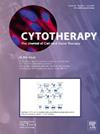THE IMMUNOSURVEILLANCE OF HYPOIMMUNOGENIC IPSC-DERIVED PANCREATIC ISLETS: IMPACT OF VIRAL INFECTIONS.
IF 3.7
3区 医学
Q2 BIOTECHNOLOGY & APPLIED MICROBIOLOGY
引用次数: 0
Abstract
Background & Aim
Immune-evasive induced pluripotent stem cell (iPSC)-derived islets are being developed as a promising cell therapy for type 1 diabetes (T1D). While abrogation of MHC-I prevents CD8+ T cell killing, it exposes the graft to natural killer (NK) cell destruction via missing-self recognition. Prior strategies attempted to mitigate NK responses by expressing inhibitory ligands but yielded inconsistent results due to the heterogeneity of NK cell populations. We devised an alternative strategy targeting NK cell activation by genetically ablating B7-H3 and CD155 ligands in MHC-I-/- iPSCs (triple knockout, T-KO). Differentiated T-KO pancreatic islets successfully evaded both T and NK cell-mediated rejection and restored glycemic control in diabetic mice. However, the safety of hypoimmune iPSC-islets in the context of infection remains uncertain. To investigate this, we evaluated in vivo immunosurveillance by challenging T-KO islets with lymphocytic choriomeningitis virus (LCMV-WE).
Methodology
hIL-15 NOG mice transplanted with luciferase-expressing T-KO islets were humanized with NK cells (day 10) and infected with 1 × 10e6 ffu/mouse of LCMV-WE (day 24). Non-humanized and uninfected mice were used as controls. Acute infection was assessed by platelet count 7 days post-infection (p.i.), while viral titers, immunophenotyping, and hC-peptide levels were evaluated 3 and 7 days p.i.. Graft survival was analyzed by IVIS and explanted organs examined at the endpoint.
Results
Thrombocytopenia indicated acute LCMV-WE infection. Viral titers were higher in NK-humanized mice compared to controls. Interestingly, hC-peptide significantly decreased in humanized mice, correlating with the bioluminescence decrease of T-KO islets. Importantly, we found that NK cells were responsible for graft rejection, as we detected CD56+ cells at the graft site. Mechanistic evaluations confirmed that NK cell activation and recognition of islet cells were NKG2D-dependent, with LCMV-WE infection causing the upregulation of the NKG2D-activating ligands MICA/B and ULBP3 in T-KO islets.
Conclusion
This study highlights that the upregulation of activating ligands other than B7-H3 and CD155 enables NK cells to re-engage in missing-self recognition, targeting infected cells. Considering the potential for viral escape, further investigations are warranted using viruses with pancreatic islet tropism to comprehensively assess the safety of hypoimmune iPSC-islets for clinical applications.
低免疫原性ipsc衍生胰岛的免疫监测:病毒感染的影响。
背景,免疫逃避诱导多能干细胞(iPSC)衍生的胰岛是治疗1型糖尿病(T1D)的一种有前途的细胞疗法。虽然MHC-I的消除可以防止CD8+ T细胞的杀伤,但它会通过缺失自我识别使移植物暴露于自然杀伤(NK)细胞的破坏中。先前的策略试图通过表达抑制性配体来减轻NK反应,但由于NK细胞群的异质性,结果不一致。我们设计了一种替代策略,通过基因消融MHC-I-/- iPSCs中的B7-H3和CD155配体(三重敲除,T-KO)来靶向NK细胞活化。分化的T- ko胰岛成功地避免了T和NK细胞介导的排斥反应,恢复了糖尿病小鼠的血糖控制。然而,低免疫ipsc -胰岛在感染情况下的安全性仍然不确定。为了研究这一点,我们用淋巴细胞性脉络丛脑膜炎病毒(LCMV-WE)攻击T-KO胰岛,评估了体内免疫监测。方法用NK细胞人源化转染转染表达荧光素酶的T-KO胰岛的hil -15 NOG小鼠(第10天),用1 × 10e6 ffu/小鼠感染LCMV-WE(第24天)。非人源化和未感染小鼠作为对照。急性感染在感染后7天通过血小板计数进行评估,而病毒滴度、免疫表型和hc -肽水平在感染后3和7天进行评估。通过IVIS分析移植物存活,并在终点检查移植器官。结果血小板减少提示急性LCMV-WE感染。与对照组相比,nk人源化小鼠的病毒滴度更高。有趣的是,hc肽在人源化小鼠中显著减少,与T-KO胰岛的生物发光减少有关。重要的是,我们发现NK细胞对移植物排斥负责,因为我们在移植物部位检测到CD56+细胞。机制评估证实NK细胞的激活和胰岛细胞的识别依赖于nkg2d, LCMV-WE感染导致T-KO胰岛中nkg2d激活配体MICA/B和ULBP3的上调。结论本研究强调,除了B7-H3和CD155之外,激活配体的上调使NK细胞重新参与缺失的自我识别,靶向感染细胞。考虑到病毒逃逸的可能性,有必要使用具有胰岛倾向的病毒进行进一步的研究,以全面评估低免疫ipsc -胰岛的临床应用安全性。
本文章由计算机程序翻译,如有差异,请以英文原文为准。
求助全文
约1分钟内获得全文
求助全文
来源期刊

Cytotherapy
医学-生物工程与应用微生物
CiteScore
6.30
自引率
4.40%
发文量
683
审稿时长
49 days
期刊介绍:
The journal brings readers the latest developments in the fast moving field of cellular therapy in man. This includes cell therapy for cancer, immune disorders, inherited diseases, tissue repair and regenerative medicine. The journal covers the science, translational development and treatment with variety of cell types including hematopoietic stem cells, immune cells (dendritic cells, NK, cells, T cells, antigen presenting cells) mesenchymal stromal cells, adipose cells, nerve, muscle, vascular and endothelial cells, and induced pluripotential stem cells. We also welcome manuscripts on subcellular derivatives such as exosomes. A specific focus is on translational research that brings cell therapy to the clinic. Cytotherapy publishes original papers, reviews, position papers editorials, commentaries and letters to the editor. We welcome "Protocols in Cytotherapy" bringing standard operating procedure for production specific cell types for clinical use within the reach of the readership.
 求助内容:
求助内容: 应助结果提醒方式:
应助结果提醒方式:


